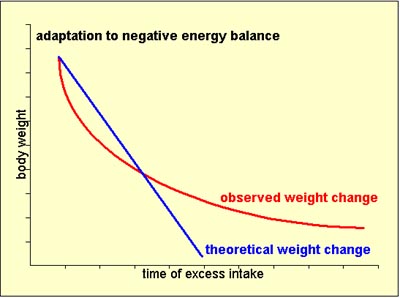 As
food intake increases above requirements there is adaptation, and the rate of
weight gain decreases until the subject is again in energy balance, but with
a higher body weight, and a higher energy requirement.
As
food intake increases above requirements there is adaptation, and the rate of
weight gain decreases until the subject is again in energy balance, but with
a higher body weight, and a higher energy requirement. Hence 1 gram of adipose tissue yields 30 kJ.
From this we can calculate a theoretical weight change as:
Hence 1 gram of adipose tissue yields 7.4 kcal
From this we can calculate a theoretical weight change as:
Assuming an energy requirement of 10 MJ (2500 kcal) /day , this means that total starvation would result in a maximum possible weight loss of:
In practice we do not see this theoretical change in weight with changes in food intake because there is adaptation.
 As
food intake increases above requirements there is adaptation, and the rate of
weight gain decreases until the subject is again in energy balance, but with
a higher body weight, and a higher energy requirement.
As
food intake increases above requirements there is adaptation, and the rate of
weight gain decreases until the subject is again in energy balance, but with
a higher body weight, and a higher energy requirement.
This is because, as food intake increases, so there is:
 As food intake decreases
below requirements there is again adaptation, and the rate of weight loss decreases
until the subject is again in energy balance, but with a lower body weight and
a lower energy requirement.
As food intake decreases
below requirements there is again adaptation, and the rate of weight loss decreases
until the subject is again in energy balance, but with a lower body weight and
a lower energy requirement.
This is because, as food intake decreases, so there is:
During the first few days of severe energy restriction the rate of weight loss is greater than that calculated from loss of adipose tissue. This is because there is a considerable depletion of glycogen reserves in muscle and liver, and when the glycogen is depleted the water trapped within the glycogen molecules is lost.